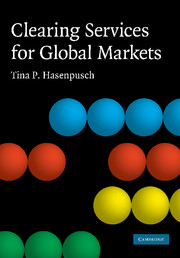 Clearing Services for Global Markets
Clearing Services for Global Markets Book contents
- Frontmatter
- Contents
- List of figures
- List of abbreviations
- Acknowledgements
- Foreword
- 1 Introduction
- 2 Setting the stage – definitions and industry setting
- 3 Defining the core issues – efficiency and network strategies
- 4 Collecting empirical insights – introduction to the empirical study
- 5 Analysing costs of derivatives clearing – transaction cost studies
- 6 Exploring theoretical basics – scale effects in clearing
- 7 What theory reveals – framework for efficiency analysis of network strategies
- 8 Checking theory against reality – case studies of network strategies
- 9 Quantifying the efficiency impact – European network strategies
- 10 Introducing the future network economy – development of the clearing industry
- 11 Summary, discussion and recommendations for future research
- Appendices
- Bibliography
- Index
5 - Analysing costs of derivatives clearing – transaction cost studies
Published online by Cambridge University Press: 19 January 2010
- Frontmatter
- Contents
- List of figures
- List of abbreviations
- Acknowledgements
- Foreword
- 1 Introduction
- 2 Setting the stage – definitions and industry setting
- 3 Defining the core issues – efficiency and network strategies
- 4 Collecting empirical insights – introduction to the empirical study
- 5 Analysing costs of derivatives clearing – transaction cost studies
- 6 Exploring theoretical basics – scale effects in clearing
- 7 What theory reveals – framework for efficiency analysis of network strategies
- 8 Checking theory against reality – case studies of network strategies
- 9 Quantifying the efficiency impact – European network strategies
- 10 Introducing the future network economy – development of the clearing industry
- 11 Summary, discussion and recommendations for future research
- Appendices
- Bibliography
- Index
Summary
As outlined above, one of this study's core research issues is the efficiency of clearing. The central criterion for determining the efficiency of clearing is operational efficiency, which is influenced by transaction costs. The economic entity relevant for the cost analysis is the clearing member view. The purpose of this study is to determine the efficiency impact of different network strategies. To accomplish this, it is first necessary to examine the transaction costs of clearing from the perspective of different clearing member types. Due to a lack of existing research and data on this topic, an original empirical study was conducted, whose findings are presented in this chapter (section 5.1). This research is unique in that it is the first study providing a comprehensive analysis of derivatives clearing costs, including both direct and indirect costs.
In a first step, findings from the empirical study are presented that serve to clarify clearing members' general perceptions of clearing costs (section 5.1.1); these findings also demonstrate the concrete relevance of the various direct and indirect cost categories (section 5.1.2). A second step identifies the core cost drivers for different clearing member types (section 5.1.3). An analysis of the interviewed clearing members' backgrounds shows that various factors can influence the way in which direct and indirect costs are perceived and reveals the ultimate importance of the different cost categories (section 5.1.4).
To provide a deeper understanding of European derivatives clearing costs, additional cost analyses are conducted (section 5.2).
- Type
- Chapter
- Information
- Clearing Services for Global MarketsA Framework for the Future Development of the Clearing Industry, pp. 133 - 194Publisher: Cambridge University PressPrint publication year: 2009


